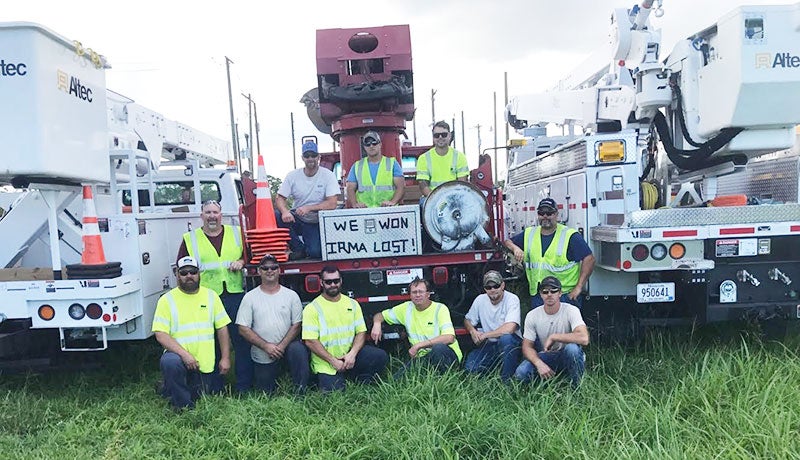Austin men help Florida recover from hurricane; Utility workers joined multi-state electrical grid repair effort
Published 1:47 pm Saturday, September 23, 2017
Power line worker Tyler Underdahl was in a precarious situation.
“There’s nowhere to run when you’re up in the bucket,” said Steve Tiegs, his Austin Utilities foreman.
The problem was they were within about 60 feet of a downed tree that they could see was crawling with bees. These were not Minnesota’s variety.
“They warned us,” Tiegs said. “They gave us about a 20-minute briefing on the different critters around there, and that was my biggest concern.”
Chances are Tiegs, Underdahl and Jeff Martinson — line workers from Austin Utilities who spent 12 days helping Florida utilities turn the power back on for about 7 million customers after Hurricane Irma tore through — were not going to see alligators, Tiegs said.
Florida’s Africanized, or killer bees, were another story, however.
“There’s bees everywhere, and we ran into two nests,” he said. “They told us they will chase you up to five miles.”
Martinson and Tiegs moved gingerly as they worked on the ground while Underdahl was above them in their truck’s bucket lift.
“And Tyler just happens to be allergic,” Tiegs said. The trio broke into laughter as they sat in an Austin Utilities headquarters conference room Thursday talking about their mutual aid experience.
They left Sept. 9 as one of 17 mutual aid crews from Minnesota municipal utilities answering the call from the American Public Power Association.
Public power utilities from all over the country sent linemen, tree crews and trucks to help. Crews went from Alabama, Arkansas, the Carolinas, Georgia, Illinois, Indiana, Iowa, Kansas, Kentucky, Michigan, Mississippi, Missouri, Nebraska, Ohio, Oklahoma, Tennessee, Texas, Virginia, Washington state, Wisconsin, and New England.
Tiegs was assigned to manage a crew of 10, which included Martinson, a line worker; and Underdahl, an apprentice lineman. Their first assignment was in Kissimmee, Florida.
The first problem they faced was traffic.
The crews had staged in a community north of Atlanta, Ga., as millions of Florida residents streamed north to escape the hurricane.
“We had to wait until the state allowed people to go south,” Tiegs said. “And then once the state allowed everyone to go south, everyone went south — 4 ½ million people trying to get home.”
Eventually, the Austin Utilities crew turned off the interstate and took back roads to get to Kissimmee.
The damage was not unlike what they’ve seen before when it comes to the type — broken power poles, downed power lines everywhere, fallen trees.
“It was more like what you get with a good thunderstorm around here,” Teigs said. “But instead of it being a small neighborhood from an area of town, it’s the entire section of the state. Everything is so widespread. There was so much.”
They began work in Kissimmee, Florida, and had power restored in about two days, he said. Then they answered a call for help from Lake Worth, Florida, where people were going on their fifth day without power in the tropical heat.
“We’d show up down the street and they would come out and for the most part approach us and follow us to see where we were going and talk to us to see when they’re getting their power back on,” Tiegs said, adding people were clearly desperate.
Restoring power is a process that can take time. What their mutual aid crew did was follow electrical feeds that extended from the central transformer, scout out the damage, return to the center and then break up into the necessary repair crews to go back out. Once repairs were done, the power would be flipped back on, often to cheers and a buzz of life.
That was short-lived once, however, Tiegs said. They had to shut down the power in one area after the newly flowing current hit some damage and caused a fire.
Aside from the bees, the crews also faced dangers from the way individual homeowners had wired in their generators and the hazard of sugar sand.
“I couldn’t really understand why the utilities there had these big four-wheel drive trucks,” Tiegs said.
Then they experienced sugar sand when they had to leave paved roads. Trucks like theirs, designed for cities, would get stuck in the sand that acted like snow, dropping out from underneath them, Tiegs said.
Hurricane season continues, with Carribbean islands taking the brunt most recently. Their Austin Utilities supervisor, Bill Bumgarner, said he doesn’t expect they’ll be helping out with those electric grids, and the trio are instead focusing on upcoming Midwest challenges.
Martinson said he had been looking forward to Minnesota weather.
“I was hoping it would be in the 60s when I got home,” he said. “It’s been a little warm.”






